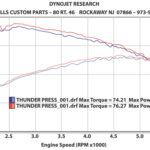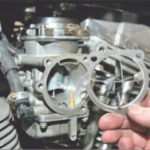Boyesen Power X-Wing
Boyesen Engineering
$129.95
800.441.1177
Reviewed by Shadow, with Ken Puzio and Kip Woodring
Like many riders, I’m always on the lookout for performance-enhancing products that don’t cost a lot or take a lot of time and effort to install. So when I learned of the Boyesen Power X-Wing—a bolt-on product purported to boost horsepower and torque for a mere $130—I figured it was right up my alley.
The Power X-Wing is a stainless steel insert designed to reduce air turbulence and increase velocity within a carburetor or throttle body, resulting, according to Boyesen Engineering, in more precise fuel control and thus greater and more responsive power—and improved fuel efficiency as well. It works on OEM (Keihen) CV, Mikuni and S&S carbs, as well as stock Harley-Davidson fuel injection systems. The installation is a fairly simple and straightforward bolt-on procedure and gaskets are provided with the product. Ken Puzio, owner of Black Hills Custom Parts in Rockaway, New Jersey, did the installation on my 2000 FXD as well as the dyno runs before and after the install.
Ken set up a series of dyno runs before the product was installed to establish a baseline against which to evaluate the Power X-Wing’s performance, and since Boyesen claims that the Power X-Wing produces acceleration gains from idle through full throttle, our dyno runs were set up for wide open throttle as well as partial throttle to better simu late real riding conditions.
The 88 ci motor on my Dyna had no engine modifications, but I’d previously installed Vance & Hines Straight Shots with the appropriate rejetting on my CV-40 carb, meaning that I was already enjoying improved performance over stock. The bike was also running quite lean, resulting in my being able to achieve over 50 mpg in normal riding situations. As a result I was curious to see what additional pep and economy the Power X-Wing would provide.
Ken began the dyno testing by doing a run with the throttle wide open. A second run was performed with a throttle stop attached on the carburetor (you can also attach one to the throttle at the grip) to limit the throttle opening to about 60 percent. He then installed the X-Wing to continue the testing. Ken removed my Dyna’s air cleaner cover and air filter, followed by removal of the breather connectors, breather bolts, backplate bolts, and backplate. If the carburetor gasket behind the backplate is not damaged, it can be reused, but we opted to use the one provided by Boyesen. Ken inserted the Power X-Wing into the carburetor through the gasket, and then installed the outer gasket included with the unit. He replaced the backplate and started the bolts, and before he tightened them, he inserted shim washers between the backplate and the engine. The breather bolts, breather connectors, air filter, and air cleaner went back on and everything was torqued to spec.
With the Power X-Wing now installed, it was back to the dyno room. Ken did another dyno pull with the throttle stop still attached. He took the throttle stop off, and did another run at wide-open throttle followed by an all-gear run. All dyno runs before and after the Power X-Wing install were done within a 10-degree window of operation (175–185 degrees) using a heat gun to ensure temperature consistency. We also made two or three dyno runs for each test configuration to achieve consistency. The air/fuel ratio was sampled during all dyno runs to make sure that ratio stayed consistent, as well.
In its sales literature, Boyesen states that dyno tests show up to 4 hp and 5 ft./lb. increases with the Power X-Wing installed on 88 c.i., 96 c.i., and 110 c.i. motors. The peak dyno numbers on my Dyna showed gains of 1.4 hp and 2 ft/lbs torque, but that doesn’t tell the whole story. Those numbers might be good for bragging rights during a dyno shootout, but we observed greater gains by sampling the numbers at typical riding ranges with the throttle open 60 percent. We saw a 2.5 hp improvement between 2500 and 4600 rpm and a 3.5 ft/lbs torque improvement between 2400 and 4200 rpm. In addition, the consistency of the air/fuel mixture monitoring showed that no rejetting was called for. While I was road-testing the Dyna, I also noticed improved throttle response, especially at lower and midrange rpms. I do very little riding at wide-open throttle so I wouldn’t have noticed any improvement in that upper range, anyway.
Once Ken saw the performance improvements on my dyno run, he decided to install the Power X-Wing in his 2004 CV-40-carbureted FLHT. His bagger has a mild 95″ engine that’s set up for touring (it has mild performance cams and 9.4:1 compression). He also had Rinehart True Dual exhausts, and he’d rejetted for those pipes by installing a 46 slow jet and a Sportster needle. After installing the Power X-Wing, Ken experienced noticeable throttle response improvement, and was quite happy to realize an 8–10 percent gas mileage improvement. And this was without implementing any other changes!
If you want to bump up your performance at a low cost and not a lot of effort, the Boyesen X-Wing can certainly fit the bill. Boyesen Engineering is no Johnny-come-lately, either. The company has 35 years of performance engineering and intake manufacturing for powersports and other vehicles under its belt. The company is so sure of its product that it’s unconditionally guaranteed to show improvements.




















